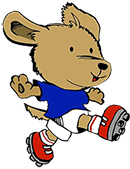Popular to the Austin community, Soccer Pups offers indoor 3v3 and 4v4 youth soccer leagues on our beautifully walled-in FIFA-approved futsal floor surface. Every weekend, our experienced coaches are on the field, guiding players through the game.
Leagues are organized by skill level and gender to provide competitive play and equal opportunities to play. To join a 3v3 and 4v4 league in the upcoming season, enroll individually in an open team, request to join a friend’s team, or bring your friends to form your own team!
Games are held on Saturdays and Sundays for 30-45 minutes


Ball Size
Number of Players
Equipment
Game Clock
Start, Restart and End of Play
“Two-Touch” Rule
Team Boxes
Ball out of Play
Indoors
Substitutions
Unlimited Substitutions
During game play, substitutions may be made at any time on an unlimited basis, provided the substituting player is within three (3) feet of the touchline at his own bench area, or off the field of play within his own bench area, before
the substitution is made. Neither the new player entering the field nor the departing player may participate in play and or gain an advantage during a period of time when they are simultaneously on the field and the ball is in play.
Fouls and Other Violations
Fouls
A free kick shall be awarded to the opposing team from the point of infraction, for a player who commits any of the following offenses (all fouls are called at the discretion of the Referee):
Time Penalties
Time penalties are NOT awarded towards a team’s foul count, if tracked.
Blue Card (2-minute penalty)
A Blue card shall be assessed for serious fouls and incidents including:
Yellow Card (4-minute penalty)
A Yellow card shall be assessed for reckless fouls and incidents including:
Red Card (Player Ejection, 5-minute team penalty)
A Red card shall be assessed for violent fouls and incidents including:
A player issued a Red card for fighting or abuse of a referee will be required to leave the building. Any player refusing to leave after being asked by the person in charge, whether it is a referee or staff member, will result in the Police called and a complaint filed.
Players receiving a Red card are suspended from all activities at SoccerPups until their case is ruled upon by management. The violator’s team captain/coach must call the facility the next day to get management’s ruling or time table of management’s ruling before the violating player may play at SoccerPups again.
A person who makes an attempt to intimidate the referee by the threat of physical abuse, pushing or attempting to make contact with the Referee can be suspended from all play at the facility for a period of at least one (1) year. A person who strikes or attempts to strike a Referee (or any employee) shall receive a permanent
SoccerPups expulsion.
A person/player receiving two Red cards in accumulation will receive a SoccerPups expulsion for at least one (1) year.
A person/player receiving three Red cards or more in accumulation can receive a Soccer Pups expulsion for life.
Other Violations
Last Man Back/Penalty Kick
If a “last-man-back” or obvious scoring opportunity foul occurs (Referee discretion), a foul is called and the offensive team is awarded a free-kick from the midfield spot. Both teams are to be behind the midfield spot. The free kick is taken on the Referee’s whistle, but play is not live. If the goal is made, a kick-off is taken. If the goal is missed, then a goal kick is taken from the touch line. Time is not stopped (Referee discretion), but the game cannot end until the free kick is taken.
Advantage Rule
Generally, advantage will be only allowed when the team against which a foul or violation has been committed will benefit from an existing offensive advantage. The Referee will penalize the original offense if the Advantage does not ensue. This is up to the discretion of the Referee. The Advantage Rule should be applied near or in the
offensive half of the field.
“Macho” Rule
In Coed, generally the lower Coed divisions, if a male player is being “reckless” in their shooting or play towards the female players on the field, a foul can be called on the offending male player. This type of play can be given a warning first and then a foul from there on out for the rest of the game. This is up to the discretion of the Referee.
Serving Penalties
© Soccer Pups 2025 - All Rights Reserved | Privacy Policy